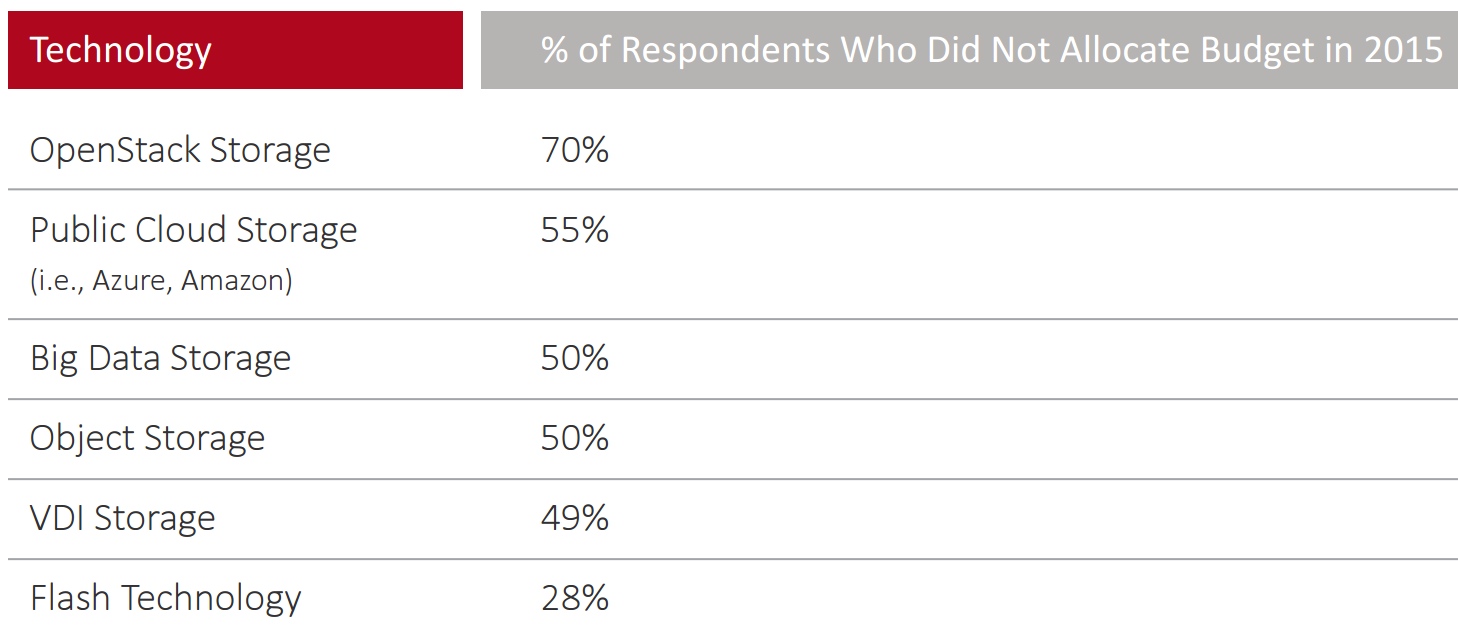Lack of Spending on Big Data, Object Storage and OpenStack – DataCore
52% of respondents expect SDS to extend life of existing storage assets
This is a Press Release edited by StorageNewsletter.com on May 20, 2015 at 2:29 pmDataCore Software Corporation announced the results of its fifth annual State of Software-Defined Storage (SDS) survey.
The 2015 poll explored the impact of SDS on organizations across the globe, and distills the experiences of 477 IT professionals currently using or evaluating SDS to solve critical storage challenges.
The results yield surprising insights from a cross-section of industries over a wide range of workloads.
The survey also probed for levels of spending on much-hyped topics, including big data, object storage and OpenStack. Unexpectedly, the findings showed that very little funding is being earmarked in 2015 for these initiatives. Some of the pause may be explained by a number of disillusionments that were disclosed in the findings.
Storage technologies not budgeted for in 2015

On the other hand, this year’s report reveals several major business drivers for implementing SDS. 52% of respondents expect SDS will extend the life of existing storage assets and future-proof their storage infrastructure, enabling them to easily absorb new technologies. Close to half of respondents look to SDS to avoid hardware lock-in from storage manufacturers, while lowering hardware costs by allowing them to shop among several competing suppliers. Operationally, they see SDS simplifying management of different classes of storage by automating frequent or complex operations. This is notable in comparison with earlier surveys, as these results portray a sharp increase in the recognition of the economic benefits generated by SDS (reduced CAPEX), complementing the OPEX savings referenced in prior years.
How much of your IT budget was budgeted for SDS in 2015?

Other surprises include: while flash technology penetration expanded, it is still absent in 28% of the cases and 16% reported that it did not meet application acceleration expectations. Also interesting is that 21% reported that highly touted hyper-converged systems did not perform as required or did not integrate well within their infrastructure. On the other hand, SDS and storage virtualization are deemed very urgent now, with 72% of organizations making important investments in these technologies throughout 2015. 81% also expect similar levels of spending on SDS technologies that will be incorporated within server SANs/virtual SANs and converged storage solutions.
Additional highlights of the survey include:
- The ability to add storage capacity without business disruption is identified as the primary reason for choosing storage virtualization software (52% of respondents). Supporting synchronous mirroring and metro clusters for HA to ensure BC and asynchronous data replication for remote site DR are also high on the list.
- More than half of the respondents (53%) say that they currently have less than 10% of capacity assigned to flash storage. The number of participants who answered that flash makes up higher than 40% of their storage capacity is only 9%.
- More than 60% of respondents experienced performance degradation or the inability to meet performance after virtualizing server workloads. When asked what the typical causes of performance problems are, 61% of participants blame slow applications, and 46% single out legacy storage devices as the culprit.
- Human errors are driving the need for greater automation. It has become increasingly clear that the complexity which accompanies data growth and diversity is taking a big toll, as 61% of respondents indicated that human error was behind application and data center outages.
SDS Technology: Moving Industry Forward
“This survey sheds new light on how IT professionals approach storage-related innovations. The data reveals that many organizations are moving away from storage functions tied to specific hardware and are deriving real CAPEX and OPEX savings and additional purchasing power by not being locked to particular hardware or being forced to go ‘all new buys’ to modernize their storage infrastructure. It also points out that heavily promoted technologies, such as object storage, are more often found at the fringes in pilot programs, where IT is hoping to assess their value,” said George Teixeira, president and CEO, DataCore. “SDS and storage virtualization software, in contrast, are providing the features that the market is demanding right now, such as continuous availability, faster performance and higher efficiency. These concrete benefits carry far more weight in 2015 spending than future promises from yet to be proven technologies and start-ups.”
“Two major surprises jump out at you from the findings,” said Deni Connor, founding analyst, SSG-NOW. “The absence of nearterm spending on big data and object storage among the majority of respondents, and the relatively small penetration of flash across these 477 organizations. Not surprising are the rising levels of investments on SDS initiatitives known to offer more immediate payoff.”
The respondents of the survey come from a diverse set of organizations, both in size and industry, providing statistically significant insights into the similarity in needs for SDS over a wide range of IT environments. Participants were located in North America, South America, Europe and Asia, in a range of vertical market segments including financial services, healthcare, government, manufacturing, education, IT services and other related industries. 45% of respondents are from organizations with less than 500 employees, 31% of respondents from organizations with between 500 and 5,000 employees and 23% from organizations with more than 5,000 employees.
The survey was conducted in April, 2015.












 Subscribe to our free daily newsletter
Subscribe to our free daily newsletter
